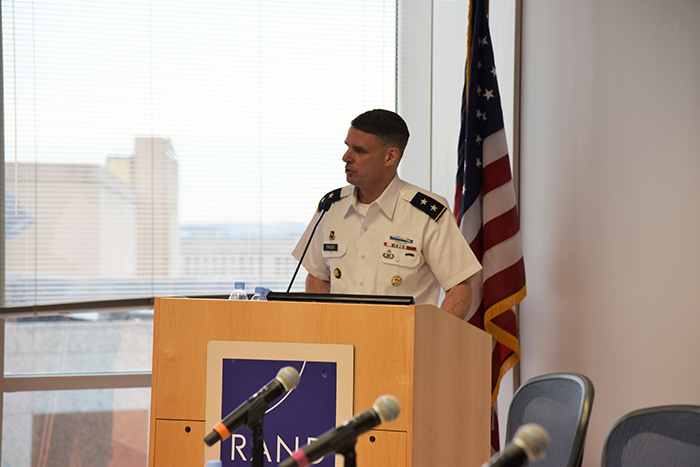Blast Injury Experts Discuss Military Occupational Blast Implications during State-of-the-Science Meeting

The Department of Defense Blast Injury Research Program Coordinating Office, supported by the RAND Corporation, hosted the 2017 International State-of-the-Science meeting in Arlington, Virginia, March 12-14, 2018. The focus topic this year was The Neurological Effects of Repeated Exposure to Military Occupational Blast: Implications for Prevention and Health.
The International SoS Meeting series was established in 2009 on behalf of the DOD Executive Agent for Blast Injury Research. These meetings support the congressionally directed EA responsibilities to identify blast injury knowledge gaps, foster collaborative research that will close these gaps, and support the development and delivery of effective blast injury prevention, mitigation, and treatment strategies for our Nation's Service members.
"The International State of the Science meetings are critically important gatherings of subject matter experts who evaluate scientific evidence and debate expert opinion to identify knowledge gaps in blast-related health," said Col. Sidney R. Hinds, program coordinator for the DOD Blast Injury Research Program Coordinating Office. "This year's meeting focused on the effects of repeated low-level blast exposures on the nervous system. This most recent SoS meeting will help the research community at large to properly direct the limited research resources through a formalized and evidence-based methodology to further our understanding of this type of exposure and to protect and aid Service Members, veterans and our civilian community."
Almost 140 subject matter experts from the DOD, other federal agencies, academia, industry and the international community participated in the meeting to assess the current state of the science on the impact of repeated exposure to military occupational blast.
The meeting objectives included:
- Describe blast exposures that are repeatedly incurred during military service
- Describe the research into the potential neurological consequences and mechanisms of repeated blast exposure
- Examine strategies for preventing injuries due to repeated occupational blast
- Identify indicators that may be used for early detection of health consequences of repeated exposure to blast
- Prioritize key research and policy gaps related to repeated military occupational blast exposure and projects and initiatives to address them
Maj. Gen. Malcolm B. Frost, commanding general for the U.S. Army Center for Initial Military Training, U.S. Army Training and Doctrine Command, provided the keynote address. Frost spoke about the operational concerns surrounding managing training and use of explosive weapons and the correlation of low level blast exposure to behavioral and neurological health. He advised that the expert panel recommendations based on the SoS meeting discussions include actionable steps that would result in tools commanders can use to assess risks and inform operational decisions.
Following the keynote address, a series of presentations explored current DOD policy and requirements, scientific literature, research, and potential solutions related to neurological effects of repeated exposure to military occupational blasts.
"The results of this meeting will help inform senior leadership's responses to the
National Defense Authorization Act Fiscal Year 2018 ![]() ,
Section 734, concerning monitoring of blast exposure in Service Members. It is our goal that these meetings will find answers that shape policy that will protect the Warfighter," said Hinds.
,
Section 734, concerning monitoring of blast exposure in Service Members. It is our goal that these meetings will find answers that shape policy that will protect the Warfighter," said Hinds.
The findings from the meeting will be synthesized into a report that will be publicly available on the
DoD Blast Injury Research Program Coordinating Office website ![]() ,
and formally staffed to the Executive Agent and DoD leadership.
,
and formally staffed to the Executive Agent and DoD leadership.














